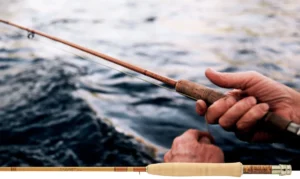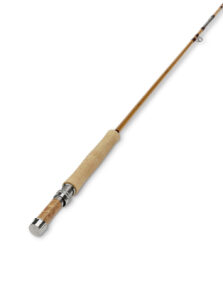
Key Takeaways
-
Bamboo fly rods require a finish that protects from moisture and wear while enhancing the rod’s natural beauty.
-
Varnish and oil are the two primary finish types, each with its own set of benefits for rod building, repair, and restoration.
-
The choice of finish depends on personal preference, intended use, and the level of durability required.
-
Applying a finish to a bamboo rod involves careful preparation, application, and curing to achieve the best results.
-
Regular maintenance ensures the longevity of the finish and the performance of the bamboo fly rod.
Choosing the Right Finish for Your Bamboo Rod
When it comes to finishing your bamboo fly rod, you’re not just giving it a shiny coat for looks; you’re sealing in years of reliable fishing adventures. The right finish not only showcases the rod’s craftsmanship but also acts as a shield against the elements. But not all finishes are created equal, and the choice you make can greatly affect your rod’s performance and longevity.
Most importantly, you’ll need to choose between a varnish finish or an oil-based one. Each has its champions and critics, and it’s crucial to understand the nuances of both to make an informed decision. Because let’s face it, a bamboo fly rod is not just a tool; it’s a companion on countless trips, and it deserves the best care we can provide.
Comparing Varnish vs. Oil Finishes
Varnish has been the go-to finish for bamboo fly rods for generations. It’s like the trusted old hat that’s been through thick and thin. It provides a high-gloss finish that is hard to beat, and its durability is top-notch. But, it requires patience and a steady hand to apply. A varnish finish is like a suit of armor for your rod – it’s tough and protective.
On the flip side, oil finishes, like the popular Tru-Oil, offer a more natural look that many anglers swear by. They bring out the innate beauty of the bamboo, highlighting its unique grain and color. Oil finishes are easier to apply and repair than varnish, making them a great option for those new to rod finishing or those looking for a simpler process.
Best Varnishes on the Market
When you’re on the hunt for the best varnish, you want something that’s going to stand up to the test of time and nature. Here are a few that have proven their worth

-
Marine spar varnish: Designed for the harshest conditions, it’s a favorite for its UV protection and flexibility.
-
Man-O-War Spar Varnish: This varnish is known for its ease of application and robust protection.
-
Epifanes Clear Varnish: A high-gloss option that’s durable and has excellent flow, ensuring a smooth finish.

Remember, the best varnish is one that you can apply correctly and that suits the conditions you fish in. Whether you’re wading through mountain streams or casting in saltwater flats, your varnish should be up to the task.
Pros and Cons of Oil-Based Finishes
Oil-based finishes, like Tru-Oil, have their own set of advantages. They penetrate deeply into the bamboo, providing a protective layer that’s part of the rod itself. This finish is also easier to touch up on the fly – a little extra oil and some elbow grease, and your rod looks good as new.
However, there are drawbacks. Oil finishes might not offer the same level of protection as varnish, especially when it comes to moisture. If you’re often fishing in wet conditions, this is something to consider. Besides that, an oil finish won’t give you the same high-gloss look that varnish will, if that’s what you’re after.
But here’s the thing: finishing a bamboo fly rod isn’t just about choosing the right materials – it’s about technique, patience, and the passion for preserving a piece of fly fishing heritage. Stay tuned, because we’re about to dive deep into the secrets of applying these finishes, ensuring your bamboo fly rod is not only a beauty to behold but a beast on the water.
Common Challenges in Finishing Bamboo Fly Rods
Finishing a bamboo fly rod is an art, and like any art, it comes with its challenges. One common hurdle is achieving an even coat without drips or sags, which can be particularly tricky with the long, slender shape of a rod. Then there’s the matter of dust and insects – tiny interlopers that can mar a perfect finish if you’re not careful. And let’s not forget the weather; humidity and temperature can wreak havoc on drying times and final outcomes.
Step-by-Step Guide to Finishing a Bamboo Fly Rod
Whether you’re aiming for the lustrous shine of varnish or the warm glow of oil, the process of finishing your bamboo rod requires attention to detail and a methodical approach. Let’s walk through the steps to ensure that your finish is as flawless as the waters you fish.
Preparing the Bamboo Surface
Before you even think about opening that can of finish, make sure your rod is as ready to receive it as a trout is to snap up a well-placed fly. Start with a clean, smooth surface by gently sanding the bamboo. Use fine-grit sandpaper and work in the direction of the grain to avoid scratches. Wipe down the rod with a tack cloth to remove all dust – because the last thing you want is a piece of grit immortalized in your finish.
Applying the Finish: Tips and Tricks
Now, it’s showtime. Apply the finish in a dust-free environment. If you’re using varnish, apply it with a high-quality brush, laying down thin, even coats. With oil, a clean rag will do the trick, rubbing it in with the grain in thin layers. Whichever finish you choose, the key is patience: don’t rush the process, and don’t goop on too much material at once.
For varnish, it’s often recommended to do several coats, sanding lightly between each once they’re dry to the touch. With oil finishes, you can apply multiple coats in a day, but give each one time to soak in and set before adding the next. This builds up a protective layer that’s not just sitting on the surface but is part of the rod itself.
Drying and Curing: Time and Conditions
After you’ve applied your finish, it’s time to let nature take its course. Curing is a process that can’t be rushed. Varnish especially needs time to harden to a durable shell. Store your rod horizontally on a rack in a dust-free, well-ventilated area. Avoid direct sunlight and extreme temperatures which can cause the finish to crack or bubble. Depending on the conditions and the type of finish, curing can take anywhere from a few days to several weeks.

Maintenance and Repair: Keeping Your Rod in Top Shape
Once your rod has a beautiful finish, keeping it that way requires a little TLC. After each use, wipe it down with a soft cloth to remove any moisture or dirt. If you’re storing it for a while, a rod tube is your best bet to keep it safe from harm.
Touch-Up Techniques for Scratches and Chips
Life happens, and so do scratches and chips. For varnish finishes, a spot repair can be done with a small brush, feathering out the edges to blend with the surrounding area. With oil finishes, a dab of oil and a rub with a cloth can often mask minor blemishes. Remember, the goal is to protect the bamboo, not just the aesthetics.
Restoration Best Practices for Antique Rods
Antique rods come with their own set of considerations. Often, the goal is to preserve as much of the original finish and patina as possible. Clean the rod with a mild soap and water solution, and dry it thoroughly. If the finish is cracked or peeling, consult with a professional before proceeding. Sometimes, less is more when it comes to restoring these old souls.
In the end, the best finish for your bamboo fly rod is one that you can apply well and that serves the purpose you need, whether that’s durability, beauty, or a bit of both. With these tips in hand, you’re ready to give your rod the finish it deserves, and ensure it’s ready for many seasons to come.
-
Choose a finish that suits your rod’s needs—varnish for maximum protection and gloss, or oil for a natural look and easy maintenance.
-
Prepare the bamboo surface properly by sanding and cleaning to ensure a smooth application of the finish.
-
Apply the finish in a dust-free environment, using thin, even coats, and allow ample drying time between applications.
-
For maintenance, regularly wipe down your rod after use and store it properly to protect the finish.
-
For minor repairs, touch up scratches and chips with the appropriate finish, but consult professionals for significant restorations, especially on antique rods.
Protecting your bamboo fly rod with the right finish is crucial for its longevity and performance. Choosing between varnish and oil finishes comes down to your personal preference and the conditions in which you’ll be using the rod. Varnish offers a high level of protection and a glossy finish, while oil provides a more natural look and is easier to maintain.
When applying a finish, it’s essential to do so in a clean, dust-free environment. For varnish, use a high-quality brush and apply thin coats, sanding lightly between each layer once it’s dry. With oil, a clean rag can be used to rub in the finish, applying multiple thin layers and allowing each to set before adding the next.
Drying and curing the finish requires patience. Store the rod horizontally in a well-ventilated, dust-free area away from direct sunlight and extreme temperatures. The curing time can vary, but rushing this process can result in a less durable finish.
Protecting Your Finish: Best Practices
Regular maintenance is key to preserving the finish of your bamboo fly rod. After each use, gently wipe down the rod with a soft cloth to remove any moisture or debris. If you’re not planning to use the rod for an extended period, store it in a rod tube to protect it from physical damage.
Touch-Up Techniques for Scratches and Chips
If your rod’s finish does suffer a scratch or chip, don’t worry—these can often be repaired. For varnished rods, a small brush can apply more varnish to the affected area, feathering the edges to blend with the rest of the finish. Oil-finished rods can be touched up by applying more oil to the blemish and buffing it out with a cloth.
Restoration Best Practices for Antique Rods
Restoring an antique bamboo fly rod requires a delicate touch. The goal is to preserve as much of the original finish as possible. Clean the rod gently with mild soap and water, and consult a professional before attempting to repair any significant finish damage. Sometimes, maintaining the rod’s character is more important than achieving a perfect finish.
Ultimately, the best finish for your bamboo fly rod is one that you can apply effectively and that meets your needs for protection and aesthetics. With the right approach to finishing, maintenance, and repair, your bamboo fly rod will be a trusted companion on many fishing adventures to come.





